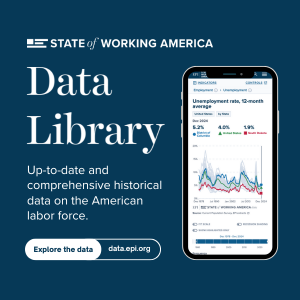Explaining the Department of Labor’s new overtime rule that will benefit 4.3 million workers
The U.S. Department of Labor issued a final rule today making changes to the regulations about who is eligible for overtime pay. Here’s why this matters:
How the overtime threshold works
Overtime pay protections are included in the Fair Labor Standards Act (FLSA) to ensure that most workers who put in more than 40 hours a week get paid 1.5 times their regular pay for the extra hours they work. Almost all hourly workers are automatically eligible for overtime pay. But workers who are paid on a salary basis are only automatically eligible for overtime pay if they earn below a certain salary. Above that level, employers can claim that workers are “exempt” from overtime pay protection if their job duties are considered executive, administrative, or professional (EAP)—essentially managers or highly credentialed professionals.
The current overtime salary threshold is too low to protect many workers
The pay threshold determining which salaried workers are automatically eligible for overtime pay has been eroded both by not being updated using a proper methodology, and by inflation. Currently, workers earning $684 per week (the equivalent of $35,568 per year for a full-time, full-year employee) can be forced to work 60-70 hours a week for no more pay than if they worked 40 hours. The extra 20-30 hours are completely free to the employer, allowing employers to exploit workers with no consequences.
The Department of Labor’s new final rule will phase in the updated salary threshold in two steps over the next eight months, and automatically update it every three years thereafter.
- Effective on July 1, 2024, the salary threshold will be raised to $844 per week.
- This is the equivalent of $43,888 per year for a full-time, full-year worker.
- In 2019, the Department updated the salary threshold to a level that was inappropriately low. Further, that threshold has eroded substantially in the last 4+ years as wages and prices have risen over that period, leaving roughly one million workers without overtime protections who would have received those protections under the methodology of even that inappropriately weak rule. This first step essentially adjusts the salary threshold set in the 2019 rule for inflation.
- Effective on January 1, 2025, the salary threshold will be raised to $1,128 per week.
- This is the equivalent of $58,656 per year for a full-time, full-year worker.
- This level appropriately sets the threshold at the 35th percentile of weekly wages for full-time, salaried workers in the lowest-wage Census region, currently the South.
- The salary threshold will automatically update every three years thereafter, based on the methodology laid out in the rule, to ensure that the strength of the rule does not erode over time as prices and wages rise.
The final rule will benefit 4.3 million workers
- 2.4 million of these workers (56%) are women
- 1.0 million of these workers (24%) are workers of color
- The largest numbers of impacted workers are in professional and business services, health care and social services, and financial activities.
- The 4.3 million represents 3.0% of workers subject to the FLSA.
Expanding overtime protections is good for workers and manageable for employers
- The final rule will result in a transfer of $1.5 billion annually from employers to workers in increased pay.
- While that increase in wages will be enormously impactful to affected workers, it represents well under one-tenth of one-percent of total wages and salaries in the U.S. economy. Employers will be more than able to adjust to the rule without negatively impacting the overall economy.
- In addition to increasing pay for many workers, the overtime rule will also reduce excessive hours of unpaid work. Before this update to the salary threshold, the cost to employers of overworking salaried EAP workers who make more than $684 weekly was effectively zero. The concept of overtime pay is designed to protect workers’ most valuable asset—their time—and to push employers to value it too.
- Automatic updating is a smart and easy way to simply maintain the labor standard established in the proposal. If the threshold is not updated automatically over time, it will steadily weaken as a labor standard until the next rulemaking, covering fewer and fewer workers as the salary distribution naturally rises over time with inflation and productivity growth.
- With automatic updating, employers will know exactly what to expect and when to expect it. They will also be able to get a reasonable sense well in advance of what the next threshold will be, because they will be able to track on a dedicated Bureau of Labor Statistics website how the 35th percentile of full-time salaried worker earnings in the lowest-wage Census region is evolving over time.
Enjoyed this post?
Sign up for EPI's newsletter so you never miss our research and insights on ways to make the economy work better for everyone.
